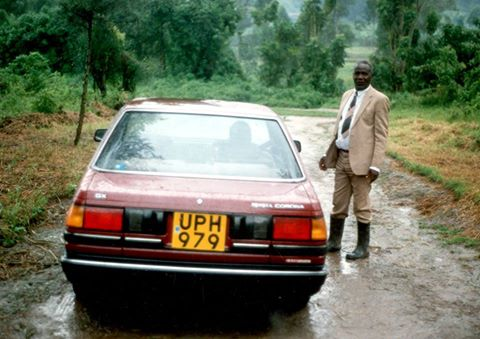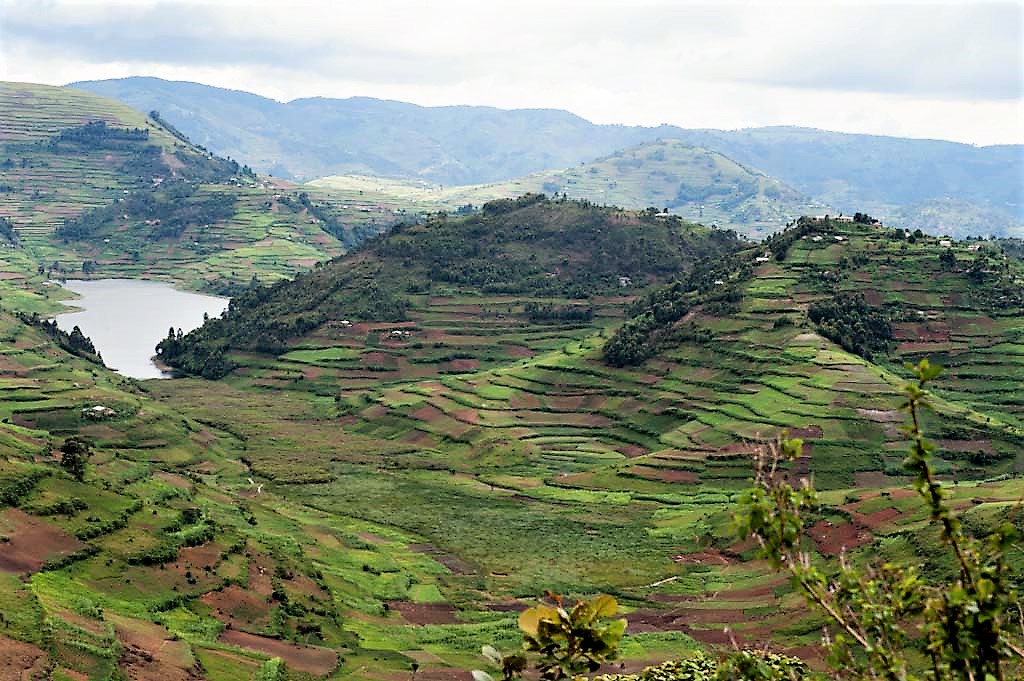 Omugurusi Ezra Kisigo Mulera in Mparo, after the rains (late 1980/early90s). Photo by Edward Nobel Bisamunyu
Omugurusi Ezra Kisigo Mulera in Mparo, after the rains (late 1980/early90s). Photo by Edward Nobel Bisamunyu
After the dry season, the rains. That is how things worked in my childhood in Mparo, Rukiga, Kigyezi. The rains of Katumba (March) soaked the hills and mountains, with millions of liters infiltrating the rich soil. The runoff was slowed down on its steep descent by the verdant blankets of thick bushes, grasses and Blackwattle trees. Weakened sheets of water arrived in the V-shaped valleys and gently found their way into the large streams and rivers, and headed down to the enormous swamps that were everywhere.
From Noozi to Nyakarambi, from Sindi to Ibumba, from Rwakijabura to Rushebeya, seemingly endless swamps stood proud, home to an ecosystem that was not there by accident. Cyperus papyrus, the dominant plant in these swamps, would sway gently in the breeze after the rains. When night fell, the call of the frogs was a sweet symphony of a thousand, albeit unnerving to a young lad walking in the dark.
These papyrus swamps were part of a nearly continuous system of public wetlands stretching from Lakes Mutanda and Murehe in Bufumbira, through OmuRubanda south of Orugano, Mafuuga and Kiirima forests, continuing south through Omuruhita and Rwakaraba, along the River Kiruruma.
At Kabaare (Kabale), the swamp branched southwest, along River Mwisi to Kitumba, all the way to Rubaya and Rwanda. The main swamp at Kabaare continued down through Kyanamira to Maziba, hugging the Kiruruma, whose name perfectly described the power of its roar as it hurried towards the waterfalls downstream.
From Muhanga to Rushebeya was all swamp. Here it would rendezvous with its sister from Mparo and head north to Kashambya and Nyarushanje, feeding the River Rushoma, along which the 30-meter waterfalls at Kisiizi lie. The swamp continued to Kebisooni in Rujumbura.
 Cyperus papyrus
Cyperus papyrus
The swamps were not just beautiful things to look at. They controlled floods, provided moisture (therefore rain), cleaned, purified and stored consumable water. They retained sediments, absorbed potentially harmful substances and detoxified the water. They recharged our underground water sources.
They were habitats for various fishes, reptiles, amphibians, small mammals and numerous insects. They were holiday homes for migratory birds that flew south during the European winter, and were favorite breeding places for crested cranes. They were a source of raw materials for ebirago and emikyeeka (mats), ebitukuru (baskets), ebishakaazo (thatch) and other building needs.
Things changed from the 1970s onward. Progressive overpopulation increased pressure on the land. According to the Uganda Bureau of Statistics, whereas the population density in Kigyezi in 1969 was 170 per sq. km., it was 314 per sq. km. in 2014.
The mountain tree cover was cut down for firewood, charcoal and construction. Every meter of soil was viewed as cultivable, resulting in cutting down of precious trees, and the grass and shrubs along the terraced edges, and outright destruction of terraces as farmers tried to maximize arable land.
Tired and bare hillsides became the perfect accelerators for torrents cascading towards the valleys. Weakened and unprotected hillside soils were easily brought down as landslides. In some areas, hillside rock and iron-ore mining created huge holes that became potential sources of rocky landslides during the rainy season.
Huge swathes of swamps were drained and turned into farms and private ranches. The one in Bubaare near Kabaare has now been turned into an airfield, celebrated by educated Banyakigyezi as development. Experts report that up to 70 percent of the swamps in Kabaare District have been drained! The remainder are being encroached upon, one meter at a time, with local leaders watching, perhaps participating in the desecration of our heritage.
The symphony of the frogs is long gone from Mparo, their sweet nocturnal song replaced by an oppressive silence that mourns the madness of man. The occasional mooing of a cow and the bleating of a goat remind one that even these animals have been deprived of watering places.
Meanwhile, silting and blockage of streams and rivers has reduced their ability to serve as drainage channels. Once great rivers like Kiruruma, Mwisi, Mineera, Rushoma, Ncwera, Birira, Ishasha and Noozi have become smaller, with some downgraded to streams. The future of Kigezi's main lakes (Bunyonyi, Mutanda, Murehe, Chahafi, Rwitanzigye (Edward) and Kanyabaha) worries conservationists.
Whenever the great rains come, the river water often overflows, flooding riverside farms, destroying crops, animals and other property. Human lives are lost on a painfully regular basis. The latest such occurrence was last week. Severe flooding hit parts of Kabaare District, including Kamuheesi (Kamwezi), Rwamucuucu and Kyanamira sub-counties. The Kabaare-Mparo road via Omurukiri was closed.
Some people declared it an act of God. Others prayed for God’s intervention. Yet others called upon the Uganda Government to rescue the people.
We sympathize with those who have suffered as a result of the flooding. We urge the Government and others who can, to assist them with emergency support against hunger, disease and homelessness.
However, we believe that this and similar disasters are a result of human greed and folly, not an act of God. It is urgent that citizens recognize and abandon the behaviors that have caused environmental degradation. This should be immediately followed by action to restore and protect what God so carefully and purposefully created for the benefit of all generations, not just for the super-greedy lot that passed through Planet Earth in the late twentieth and early twenty-first centuries.

Terraced hills and mountains, Kigyezi, Uganda
Five key roles that the Government should play are:
(1) mass education about environment restoration and conservation;
(2) legislation of mandatory return and restoration of the drained swamps and the deforested hillsides;
(3) escalation of family planning programs to slow down population growth in areas like Kigezi;
(4) abandonment of policies that put industrialization and other economic pursuits above environment protection;
(5) creation of a national Tree Planting Day.
God gave us a verdant Earth, complete with great wetlands that serve many functions. Humans altered it. Only humans can restore the Earth to what God meant it to be.